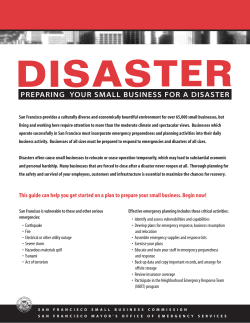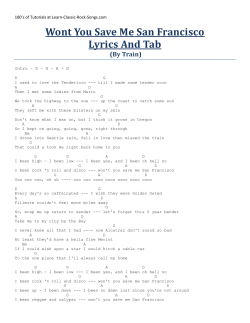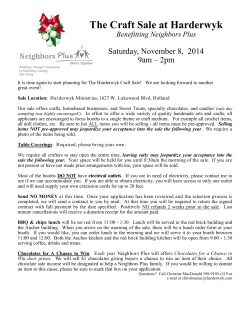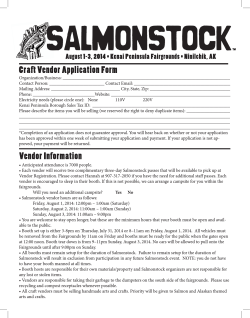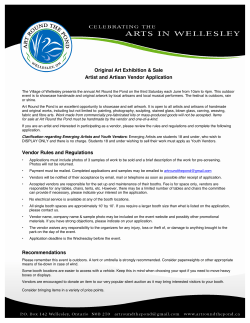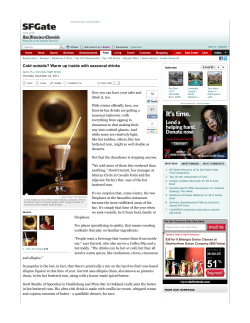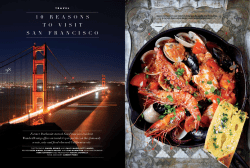
How to Sell at a Farmers Market ʼ
Presents How to Sell at a Farmersʼ Market A Step-by-Step Guide HOW TO SELL AT A FARMERS MARKET About This Guide You are living in a city that loves food, in an area where the large majority of the countryʼs greens are produced and in a place where producers themselves are adored. It is a unique setting for food—a locale that encourages us to celebrate in the act of eating as well as that of producing. But given all that, entrance into this community is often difficult, and the regulations and laws surrounding formal entry are often times intimidating. This guide will provide you with a step-by-step look at ways in which small businesses can grow through farmersʼ markets. What You Will Find In This Guide I. Types of Market Vendor Opportunities a. Hot Food Booths and Specialty Foods II. An outline of the costs and benefits of an outdoor vending location; a. Equipment Costs III. The permitting process a. San Francisco Health Department b. San Francisco Fire Department c. Permitting Costs IV. Setting Up Shop a. Sign, Menu, Costs, Line, Mis-en-Place b. Step-by-Step c. A Checklist for Going to Market V. Appendices a. Department of Public Health (DPH) Farmersʼ Market Chart b. DPH Fee Worksheet c. DPH Temporary Food Facility Application (for Hot Foods) d. DPH Certificate to Operate Application (for Packaged Foods) e. DPH Retail Guidelines f. DPH Operations Checklist g. Additional Operations Guidelines h. Farmersʼ Market Calendar 1 HOW TO SELL AT A FARMERS MARKET Hot Food Booths and Specialty Foods There are 2 types of vendors that will sell at farmersʼ markets. Each of these business types will offer significant advantages and disadvantages, and it is important to weigh those costs against the particular event that you are considering. Hot Food Booths: Hot food booths are popular attractions at markets. They are also the most expensive to establish and provide the most difficulty in terms of permitting, equipment and so forth. People often look forward to eating at markets while they get their shopping done, or as lunchtime option. It is incredibly important that your customers know what it is they you are selling; samples, signs, and visual indicators are all essential aspects of a successful food booth. You want to keep your menu limited, but exciting, and be careful to choose menu items that will be easy to produce and serve. For some examples of successful hot food booths see: Primavera and Namu at The Ferry Building Farmerʼs Market (Saturdays, San Francisco Embarcadero), El Huarache Loco (Alemany Market, Saturdays and Sundays), etc. Specialty Foods: The sales of specialty foods at markets can provide an excellent chance for producers to reach a very specific target market. Fresh and seasonal products often find a consistent home in farmerʼs markets. Finally, and perhaps the most important benefit, the cost for a specialty food producer in a market is often quite low, allowing the vendor a little more flexibility in terms of the quantity of their sales. For some examples see; Bay Breads (Farmerʼs Markets throughout the city), Happy Girl Kitchen (Ferry Building Farmerʼs Market), the honey vendors at Alemany Farmerʼs Market, and so forth. Very Basically What You Will Need An Idea: All of this, of course, begins with an idea. What are you going to be selling, will you benefit from selling directly to customers, who are your customers? If you have not written this process into your business plan, does it work with your business plan? A Commercial Kitchen: Any market (or fair, festival and retailer, for that matter) will want to know, immediately where you are cooking. In order to sell legally, you must be producing your food in a commercially licensed kitchen. That could be a restaurant that rents or leases you space, a church with a commercial kitchen, a rental facility, or, of course, a commissary like La Cocina. Commercial liability insurance. 2 HOW TO SELL AT A FARMERS MARKET A Business License: As a seller, you are required to have a business license and a business name at the very least. Depending on your business you may also need a sellerʼs permit or some other form of permitting. This will be addressed in your business plan. A Booth: You will need the physical structure from which to sell. A Location: Finally, you will need a place to set up this business. And that is where this guide begins! Farmersʼ Markets Special events, like street festivals, farmerʼs markets and weekend fairs provide an excellent, lowcapital option for entrepreneurs to expand their market. There are over 100 flea and farmersʼ markets in the Bay Area. It is important for a vendor to keep in mind several key questions when researching which of these many opportunities may prove beneficial. When approaching a potential market, take a week or two and visit the market as a consumer, ask yourself a set of questions that will allow you to assess how you think your product will sell in that particular market. Very basically, the following list will give you an idea of the sorts of information that may prove useful; I. II. III. IV. V. What are the hours of the market? a. When is the market busiest/slowest? b. What time do the vendors show up/break down? How busy is the market? a. Is it consistent or seasonal? b. Is it affected by the weather? c. Are the shoppers there to browse or to buy specific things? Vendor Competition a. Is someone else selling something similar to your product? b. Does there seem to be room in the market for your product? Consumer Base a. Who are the customers at the market? b. What are they spending their money on? c. Is there expendable income? d. Do the customers match your target clientele? Will they be familiar with your product? Technical Details a. Is electricity available? b. Trash? Running water? c. Who is the market manager? Is he/she involved in the market? d. Can you get to and from the market? Can your customers? On the following page you will find a worksheet designed to map these questions and their answers; The ideal answer indicates, in your mind, what the perfect selling conditions would be. Your observation will then be placed next to this ideal, and you will have an opportunity to asses the realistic feasibility of this project. 3 HOW TO SELL AT A FARMERS MARKET Question Ideal Answer Observation Relevance Score (110) Market Hours What would you like the What is your actual How answer to be? observation? important? What are the busiest hours? What are the slowest hours? When do the vendors show up/break down? Market Occupancy Consistent or seasonal? Weather based? (Is it covered or open? Sunny or shaded?) Vendor Competition Is there any product similar to yours? (Also consider the neighborhood and community) Is there physical space for you in the market? Consumer Base What are the customers like? Do they match your target customer profile? What do they spend their money on? Are they browsing or shopping with a purpose? Is there expendable 4 HOW TO SELL AT A FARMERS MARKET income? Technical Details Is there electricity? Is the market manager on hand? Can you get to and from the market? Can your customers? Is there trash on site? TOTAL What You Should Know About Costs While markets do offer a low-capital opportunity to gain new access to markets, they are not without their costs. Every business will require a different set-up, but in your preparation for your booth you should think carefully about what your costs will be so that you can minimize the costs and set realistic prices. This section will give you a general outline of the sorts of costs your business may encounter. Equipment Costs I. Booth; all vendors will, at the very least, need a booth. Hot food vendors will, most likely, need two 10x10 booths and specialty food producers will need one. Health department requirements vary from county to county, however, the general requirements call for a 10x10 fire-resistant booth that closes on three sides. a. Booths can be found at EZ-Up (www.ezup.com), Caravan Canopy (www.caravancanopies.com) Costco, Target and other larger supply stores. II. Signage; all vendors will also need, per health department regulations, a large sign. The sign must include the business name, address, and telephone number in typeface at least 3 inches high (per SF Health Department). For more information on booth regulations see Appendix G. a. Banners can be made at Kinkoʼs or specially ordered (www.halfpricebanners.com) III. Hot Food Equipment; hot food vendors must first consider whether they will be cooking using propane or electricity. Electricity will allow vendors to skip the permitting process with the SF Fire 5 HOW TO SELL AT A FARMERS MARKET Department, however, there must be an investment in a generator, and a quiet one at that. Propane equipment will provide you with a better cooking surface and will relieve the need for a generator, but it will also require more work on the permitting process (more information later). When researching your cooking equipment be sure to consider what you will be cooking, how you will transport the equipment and whether you will be able to get the piece approved by all departments. a. Examples; Big John Grills (www.bigjohngrills.com), A-1 Party Rental (www.a-1partyrental.com) IV. Temperature Control; hot food vendors will also need to maintain the temperature of their food, either hot or cold. Vendors can consider a cooler, a convection oven, or a steam table. Coolers are the least efficient, but the cheapest. Ovens and steam tables are expensive and will require a generator. a. For storage ideas see www.cambro.com. Coolers can also be found at Economy Restaurant Fixtures and other larger stores. V. Transportation; vendors will need to keep in mind that they will need to travel to and from the site. These costs include both the vehicle itself as well as the gas costs. VI. Storage; vendors will need to store their equipment, should they use a large amount of equipment. VII. Labor; Keep in mind that you will not be able to work your booth alone. Factor in your labor costs when considering an event. Think about roles as well. Who will be doing what? When will you give them their job description? The Health Dept also requires a Workersʼ Compensation declaration form. VIII. Permits; The permitting process will vary based on the county, the event itself, and the vendor. You will find a chart for permitting costs in the chapter on permits. IX. Proper Signage (Menus); Beyond the initial sign stating your business name you will need to present signs that list your menu items clearly and largely, and pictures can certainly help your cause. Chalkboards, magnets and banners. You can use this worksheet to estimate your cost per event. Use the first column (your cost) to calculate total cost, then divide that by the days of the event. 6 HOW TO SELL AT A FARMERS MARKET Item 10x10 Booth Banner Average (estimated) Cost $150.00--$250.00 $100.00 (3x10 foot) Hot Food Equipment Purchase Mobile Gas Griddle (36”) $1,100 + Rental $63.00 + delivery $70 propane tank Mobile Gas Grill (54”) $1,900 $130.00+delivery Gas Steam Table $270.00 N/A Electric Steam Table $200.00 N/A Temperature Control Transportation Storage Labor Permits $10/per hour x # of hours See permit sheet Menus TOTAL 7 Your Cost Cost per Day HOW TO SELL AT A FARMERS MARKET Permits What You Will Need to Operate At the end of this section you will find a worksheet that will give you a start in understanding the permit process here in San Francisco. It is important to keep in mind that permits are different in every county, and every vendor should research the necessary permits before investing too heavily in their location. In general, food vendors will need a health department permit to operate. If food is being prepared on-site vendors will generally work with the Special Events staff, though if the food needs no temperature control, a one-time permit is usually available through the Department of Public Health. The Fire Department monitors the use of any open flame, be it gas, candles or charcoal. Should the vendor use electricity (so long as the generator fueling the electricity is smaller than 20 gallons), the Fire Department will not be involved. San Francisco Health Department It is important to look at the information that they provide ahead of time, and to follow the clear rules that they establish. Most of their staff work out of the office, so itʼs a good idea to call early and to make appointments. Contact: Environmental Health Section Attn: Food Safety Program 1390 Market Street, Suite 210 San Francisco, CA 94102 (415) 252-3800 http://www.sfdph.org/dph/eh/Food/CertFarmMkt.asp Melinda Tyler Office: (415) 252-3800 Fax: (415) 252-3842 Email: Melinda.Tyler@sfdph.org 8 HOW TO SELL AT A FARMERS MARKET San Francisco Fire Department The San Francisco Fire Department does not make appointments, though their office is open for most of the day during the week (they do close daily for one hour at lunch). Most permits will need at least five business days, if not more, to clear. Contact: San Francisco Fire Department Permit Section of the Bureau of Fire Prevention 698 Second Street San Francisco, CA 94107 (415) 558-3303 www.sfgov.org/site/fire_index.asp?id=4460 Business Type Hot Food Vendor Health Department (DPH) Permit 1) Application Fee for High Hazard =$99 2) Permit Fee= $250/quarter Specialty Food Vendor Fire Department (SFFD) Permit You will need to get your For more costing equipment approved by help see Appendix SFFD. Once approved a B. yearly permit will cost $330. 1) Application Fee for Most likely you will not need High Hazard =$38 a permit from the Fire 2) Permit Fee= Department. $250/quarter Mobile Cart 1) Annual “MFF” Permit to You will need to get your Vendor Operate available through facility approved by SFFD. “Mobile Food DPH ($452-$1387). Once approved a yearly Facility” permit will cost $330. 9 Total Cost HOW TO SELL AT A FARMERS MARKET For Additional Permit Information by County County Health Department San Francisco (415) 553-1115 www.sfgov.org/police (510) 567-6700 Fax (510) 337-9134 www.acgov.org/aceh (415) 499-6907 Fax (415) 507-4120 www.co.marin.ca.us/ehs Alameda County (Oakland, Berkeley, etc.) Marin County Setting-Up Shop Your Booth: Every booth begins with a 10x10 space, enclosed on three sides. But once you have this structure itself youʼve only really created a shell for your business. Your business will not begin until youʼve filled in the shell. Outside the Booth: Signage: Your signs are incredibly important. For an example of just how important take note at any festival the direct relationship between the size and clarity of a businessʼ signs and their occupancy. In your sign you want to make clear what the food is that you are offering and, if at all possible, you want to draw people in. Think about the placement of your signs, the height, the colors and so forth. Menu: Your menu is your first and most important chance to convince your customers to eat your food. For food booths your menu should be concise, consciously priced and well-organized. Menus should be clear about everything that comes with your food, the portion size and the price. In a busy situation you want to minimize the inessential and potentially time-consuming details. Also consider the placement of the menu, the size of the text, and even the legibility. Inside the Booth: 10 HOW TO SELL AT A FARMERS MARKET Tables: You will need at least three tables. In front of you will be your counter, to the side your prep table, and in back a miscellaneous table that will be used to suit your individual business. Counter: You should consider everything about your counter, including the height. This will be the face of your business and for that reason you will want it to be clean and organized. Your counter should include your promotional materials, napking and cutlery, any condiments that your customers may want, and plenty of personal touches. Prep Table: We will talk about mis-en-place (where things go) below, but think carefully about your prep table. At a busy moment it is this area that will be hit the hardest in terms of disintegration. Plan accordingly. Miscellaneous This table will allow you storage room, more working space, or whatever use you deem necessary. Use it wisely. Mis-en-Place Mis-en-place is a fancy French word that, essentially, means where things go. It is the concept that a cook can have things in order. Cooking is, at its heart, a messy science filled with unpredictability. Mis-en-place is the effort to harness and organize that essential disorganization to minimize the impact of high-pressure cooking as much as possible. Thinking hard about where things should go, in order to facilitate movement in a small-space, in order to shorten prep times, and so forth will help a business tremendously. The more you think about these moments ahead of time, the easier your job will be when it matters the most. Cash Register Think carefully about this most important piece of equipment. Choose a place to put your money where it is easily accessible, easily organized and safe. It can be a lockbox, an electronic machine, or a belt that you where. The more organized your cash register is, the less likely you are to make the easy mistake of giving someone the wrong change, or misplacing your money. When you begin your day, count the money in your register, and do what you can to make sure that you begin everyday with plenty of change; $1s, $5s, and coins. These days more and more vendors are accepting credit cards via Square and other iPad POS systems. Other Booth Requirements Things like hand-washing and dish-washing stations are addressed in Appenix A. Booth Set-Up 11 HOW TO SELL AT A FARMERS MARKET Use these drawings to sketch out what you think your booth might look like. Be as detailed as possible in the space provided. All sides are 10 Feet Long. Remember to include your cooking equipment, your staff, and so forth. 12 Taking it Step-By-Step, A Timeline This is your chance to start planning, one of the most important parts of your business. Like mis-en-place, a wellwritten and organized timeline will let you worry about the most important and unpredictable things when they come, while having the most predictable taken care of in advance. Begin with your projected start date, and then work backwards, conscious of when you should have things done. The more time you give yourself, the better. Projected Start Date: _________________________________________ 3 or More Months Before: 1) Write out your idea succinctly. 2) Develop and design your menu, with pricing. 3) Analyze your costs and the projectʼs feasibility 2 or More Months Before 4) Design your booth set-up. Be as detailed as possible. 5) Design your signs and actual physical menu. 6) Source your equipment 7) Begin acquiring your permits 1 or More Months Before 8) Finalize permits 9) Finalize and purchase/rent your equipment 10) Find and secure labor for event 3 Weeks Before 11) Finalize and print menus and signs 12) Review site-specific requirements 2 Weeks Before 13) Set-up your booth once, as practice. 14) Cook everything once from your menu, to understand timing 1 Week Before 15) Prepare all food for event 16) Arrange transportation and create your own timeline for the coming week 17) Go to the bank and get $ for register 1 Day Before 18) Pack as much as possible the day ahead of time 19) Check all equipment and supplies 3 Hours Before 20) Pack equipment and leave for site 2 Hours Before 21) Arrive, unpack and set-up (booth, counter, equipment) 1 Hour Before 22) Finalize set-up, review the ordering process, signs, etc. 30 Minutes Before 23) At this point everything should be read. Relax and good luck. Completed? _______ _______ _______ _______ _______ _______ _______ _______ _______ _______ _______ _______ _______ _______ _______ _______ _______ _______ _______ _______ _______ _______ _______ San Francisco City and County Department of Public Health Environmental Health Section Consumer Protection Program Adjunct Facilities at Farmers Markets Mobile Food Facilities Vendors selling prepackaged or nonprepackaged non-potentially hazardous foods or preparing, processing, and/or cooking potentially hazardous foods from a vehicle. Specific Farm or Retailer Vendors selling prepackaged or whole foods. Hot Dog Cart Catering Truck Taco Truck Waffle Truck Coffee Cart Annual Permits from SFDPH o Vendors Retail Food Vehicles (Consumer Protection) o o o o Mobile Food Facilities Pushcarts, Prepackaged Food Truck, or Enclosed Mobile Preparation Unit: o o o o o Certified Food Vendors Certified Producers or Farmers Imelda Reyes imelda.reyes@sfdph.org (415) 252-3825 SFDPW: pending Market Manager and Vendors Melinda Tyler Vendors cooking or selling prepackaged or non-prepackaged foods from a booth/tent/truck/cart. Onsite assembly of food o o o o o o o o o Popcorn Falafel Fresh Juice Smoothies Hot coffee Pizza Empanadas Cheese (if portioned on site) Mobile Food Trucks/Carts Quarterly Permits: valid for up to 25 Annual Permits Consumer Protection melinda.tyler@sfdph.org (415) 252-3852 Temporary Event Vendors Pre-Packaged Foods Open-Air Seafood Live Animals Bakery Items (Agriculture) o Flowers o Honey o Nuts o Fruits or Jams o Cheese (FDA) o Public Property: SFDPW – pending Private Property: SFDPH Consumer Protection Edwin M. Lee, Mayor Barbara A. Garcia, MPA, Director of Health Rajiv Bhatia, M.D.,M.P.H. Director of Environmental Health Rhodora Lino Agriculture rhodora.lino@sfdph.org (415) 252- 3832 Carmen Kern Weights & Measures carmen.kern@sfdph.org (415) 252-3851 days of operation during the quarter (90 day period). Re-apply at least 2-weeks before every quarter start – January, April, July, and October. o Market Manager and Vendors Alicia Saam Consumer Protection alicia.saam@sfdph.org (415) 252-3811 SFFD: (415) 558-3300 San Francisco City and County Edwin M. Lee, Mayor Barbara A. Garcia, MPA, Director of Health Rajiv Bhatia, M.D.,M.P.H. Director of Environmental Health Department of Public Health Environmental Health Section Consumer Protection Program Adjunct Food Facilities at Farmers Market Fee Worksheet (Two Tiers) I. APPLICATION FEE: A) Sponsor B) High Hazard Facility On time Late Totals $138.00 $276.00 ________ _____ x $99.00 ________ _____ x $198.00 C) Low Hazard Facility ______ x $38.00 ________ ________ ______x $76.00 ________ Total = ________ Note: application fees charged once for initial processing or changes _____________________________________________________________________________ II. INSPECTION/PERMIT FEE: nonrefundable flat fee per facility (truck/booth/cart) A) High or Low Hazard Facility _______ x $250.00 per quarter _________ Total = ________ Grand Total (Application Fee + Inspection/Permit Fee) check payable to SFDPH PLEASE SEND CHECK TO SFDPH: Federal Tax ID#: 94-6000417 From: ___________________________________________ Fax: ____________________________ Event Name: _____________________________________ Date: Consumer Protection Temporary Events Program = ____________ 1390 Market Street, Suite 210, San Francisco, Ca 94102 Attn: Alicia Saam Department of Public Health Temporary Events Coordinator Phone (415) 252-3811 Fax (415) 252-3842 San Francisco City and County Department of Public Health Environmental Health Section Consumer Protection Program Edwin M. Lee, Mayor Barbara A. Garcia, MPA, Director of Health Rajiv Bhatia, M.D.,M.P.H. Director of Environmental Health Adjunct Food Facilities at Farmers Market Fee Worksheet Calculation: I. APPLICATION FEE* (non-refundable) to SFDPH A) Sponsor $138.00 (initial application or record update) B) High Hazard Facility $99.00 (initial application or record update) C) Low Hazard Facility $38.00 (initial application or record update) Example: Quarterly event with 3 new high hazard facilities & 2 new low hazard facilities A) Sponsor: B) High Hazard (3): C) Low Hazard (2): $138.00 3 x $99.00 = $297.00 2 x $38.00 = $76.00 Total: $511.00 payable to SFDPH Note: facility application fees charged once for initial processing or changes _____________________________________________________________________________ II. INSPECTION/PERMIT FEE* (non-refundable) to SF Tax Collector A) Flat fee of $250.00 per facility (booth) Example:: 5 vendors (same as above) A) 5 x $250.00 = $1,250.00 Total: $1,250.00 payable to SFDPH Grand Total (application fee + inspection/permit fee) = $511.00 + $1,250.00 = $1,761.00 * Possible 3% increase per fiscal year Consumer Protection Temporary Events Program 1390 Market Street, Suite 210, San Francisco, Ca 94102 Phone (415) 252-3811 FAX (415) 252-3842 San Francisco City and County Department of Public Health Environmental Health Section Consumer Protection Program Edwin M. Lee, Mayor Barbara A. Garcia, MPA, Director of Health Rajiv Bhatia, M.D.,M.P.H. Director of Environmental Health Farmers Market Concessionaire Application This application is to be completed by each Temporary Events Food Facility adjunct to Farmers Markets. The sponsor shall collect all the applications and submit them as a packet at least two weeks prior to the event. Name of Farmers Market:_________________________________________________________________ Location: __________________________________________________ Date(s): ______________________ Time food concession will be ready for inspection: ______________________________________________ Applicant/Company Name: ________________________________________________________________ Address:________________________________________________________________________________ Phone:_____________________Fax:____________________E-mail:_______________________________ Number of food vendors: _________ Number of 10’ x 10’ booths:_________ Number of carts: __________ On-site representative: ______________________________________________________________________ Name of facility for equipment cleaning and sanitizing, equipment storage, and food storage (commissary): Address:__________________________________________________________________________________ Phone:____________________Fax:____________________E-mail:_________________________________ Travel time from off-site preparation to event location: ____________________________________________ Hand Washing Facilities: plumbed sink: ___________________________________________ Warm H2O gravity flow station: ___________________________________________ Utensil Sanitizing Method: (3) compartment sink: ___________________________________________ Other method approved by SFDPH: ___________________________________________ Temperature Control Methods: Hot (135°F or above): _________________________________________ Cold (45°F or below): _________________________________________ Food Item Off-Site Cooking Procedures Holding Temp. Methods Prep. Example: raw chicken yes grill to internal temp= 165°F sterno chafing dishes I have read and understood the Concessionaire Operating Requirements & Checklist attached to this form_______(initial). Applicant signature: __________________________________________ Date: _______________________ Printed name: ____________________________________________________________________________ FARMERS MARKET FACILITIES & TEMPORARY EVENTS PROGRAM Phone (415) 252-3811 1390 Market Street, Suite 210, San Francisco, CA 94102 fax (415) 252-3854 CITY AND COUNTY OF SAN FRANCISCO DEPARTMENT OF PUBLIC HEALTH ENVIRONMENTAL HEALTH SECTION 1390 Market St., Ste 210, San Francisco, CA 94102 APPLICATION FOR PERMIT TO OPERATE OR CERTIFICATE OF SANITATION Type Of Business: Ownership Change Date of Application: New Installation BUSINESS NAME AND ADDRESS: Reclassification Record Purpose BUSINESS PHONE NO.(S): MAIN CONTACT: CROSS STREET: Partnership Sole Owner Corporation LLC Permit to be Issued in Name(s) of: Specify Business Name, Business Owner or Principal Officers. (Print) Owner/Corporation Mailing Address (Print) Emergency Contact & Phone No.: Owner Phone. No Alternate Phone .No. No. of Toilets: Sq.Ft. of Establishment: * SIGNATURE(S) OF APPLICANT(S) X X X X * If Partnership, all partners must sign. If Corporation, authorized Officer must sign. FOR OFFICE USE ONLY laundry machines Special Notes: Yes Food Safety Certificate Required: No washers: dryers: extractors: Certifying Agency: Exp. Date: Certified person: Certificate No.: total no.: Filing Fee Advertising and Posting Fee Fire Department Referral Zoning Referral DBI Referral Out of Business Notification INSPECTOR'S REPORT To the Director of Public Health: After having made a careful inspection in the above case on I RECOMMEND the issuance of a New Permit to operate I DISAPPROVE the issuance of a New Permit to operate for the following reasons: PRINCIPAL INSPECTOR DISTRICT NO. CENSUS TRACT PERMIT NO. , 20 INSPECTOR TYPE OF PERMIT/CLASSIFICATION LOC ID: City and County of San Francisco DEPARTMENT OF PUBLIC HEALTH ocCUPATIONAL & ENVIRONMENTAL HEALTH Gavin Newsom, Mayor Mitchell H. Katz, M.D. Director of Health Rajiv Bhatia, M.D., M.P.H. Medical Director Certified Farmers’ Market Sanitation and Operational Requirements for Retail Food Vehicles/Vendors Structural Requirement: All pre-packaged food booths shall have overhead protection. Operational Requirements: A. All pre-packaged foods shall be stored at least six inches off the ground, B. Approved toilet and hand washing facilities shall be available within 200 feet of the Market, C. No live animals, birds, or fowl shall be kept or allowed within 20 feet of any area where food is sold or held for sale, D. All garbage and refuse shall be stored and disposed of in a sanitary manner, and E. Food preparation is prohibited with the exception of food samples. Distribution of food samples may occur provided that the following sanitary conditions exist: 1. 2. 3. 4. Samples shall be kept in approved, clean covered containers. All food samples shall be distributed in a sanitary manner. Clean, disposable plastic gloves shall be used when distributing food samples. Clean water, soap and sanitizer shall be available for utensil washing and/or hand washing (example of sanitizer – Chlorine or Ammonia). CONSUMER PROTECTION Phone (415) 252-3800 1390 Market Street, Suite 210, San Francisco, CA 94102 fax (415) 252-3842 Department of Public Health Edwin M. Lee, Mayor Barbara A. Garcia, MPA, Director of Health Environmental Health Rajiv Bhatia, M.D.,M.P.H. San Francisco City and County Consumer Protection Director of Environmental Health TFF Concessionaire Operating Requirements & Checklist As an event concessionaire, you are responsible for submitting the Food Concessionaire Application to the event sponsor. You are also responsible for ensuring food safety inside your booth. The checklist below will help you organize your efforts. Additionally, the Temporary Events Coordinator will answer any questions you have regarding requirements, regulations, and proper food handling at Temporary Food Facilities (TFF) in the City and County of San Francisco. 1. Food Booth Construction: Provide the name of the facility, city, state, ZIP Code, and name of the operator legibly and clearly visible to patrons. The facility name shall be in letters at least three inches high and be of a color contrasting with the surface on which it is posted. Letters and numbers for the city, state, and ZIP Code may not be less than one inch in height. Separate grills and barbecues or other approved cooking equipment from public access by using ropes or other approved methods to prevent contamination of the food and/or injury to the public. Provide overhead protection for all food preparation, food storage, and warewashing areas. Bring extra an umbrella or tenting if necessary to protect coolers or other tables near grill area. Provide enough tables or shelving to keep all food and food contact items off the floor. Provide floors constructed of concrete, asphalt, tight wood, or other similar cleanable material. 2. Food Handling & Sanitary Requirements: All food that is sold, given away, or dispensed from a Temporary Food Facility shall be from an approved source (e.g., licensed wholesale or retail food facilities). No food prepared or stored in a private home may be used, stored, served, offered for sale, sold, or given away to the public. Ensure refrigerator trucks are operational and holding food at or below 41oF. Ensure adequate ice is available throughout the event. Ice used for refrigeration/cooler purposes shall not be used for consumption in food or beverages. Elevate bulk bags of ice. Ensure grey water receptacles and adequate trash/recycling receptacles or services are provided by the event sponsor. Ensure all water used for food processing or food contact surfaces during the event is potable or from potable sources. Ensure adequate toilet facilities are provided with hand wash facilities equipped with warm water, liquid soap, and single use paper towels within 200 feet from the food vendors. TEMPORARY EVENTS PROGRAM Phone (415) 252-3811 1390 Market Street, Suite 210, San Francisco, CA 94102 fax (415) 252-3854 Department of Public Health Edwin M. Lee, Mayor Barbara A. Garcia, MPA, Director of Health Environmental Health Rajiv Bhatia, M.D.,M.P.H. San Francisco City and County Consumer Protection Director of Environmental Health All food that is sold, given away, or dispensed from a Temporary Food Facility shall be from an approved source (e.g., licensed wholesale or retail food facilities). No food prepared or stored in a private home may be used, stored, served, offered for sale, sold, or given away to the public. 3. Event Day & Set Up: Ensure your booth set up meets SFDPH’s requirements: overhead protection for all foods and food contact surfaces; single use articles for use by the consumer; all foods and utensils stored at least 6-inches off the ground; foods are held, cooked, and reheated to approved temperatures. Facility and Food Handling Requirements can be found on SFDPH’s website: http://www.sfdph.org/dph/EH/Food/Permits/permitSpecEvents.asp Hand wash station: 5 gallon water container with dispensing valve to leave hands free, liquid pump soap, single use paper towels, and collection bucket under water container. Hand sanitizer is not a replacement for hand soap or hand washing but may be used after properly washing hands. Utensil washing/sanitizing station: label each container and adequately fill with potable water 1. soap and water 2. rinse water 3. sanitizer Wiping cloth sanitizing bucket before beginning any food preparation. Food handlers must be in good health; wear clean outer garments; restrain hair; wash hand with soap and warm water prior to the start of food preparation activities, after using the toilet, after smoking, eating, and whenever necessary to prevent contamination of food; refrain from eating in food related areas; and not commit any act that may result in the contamination or adulteration of food, food contact surfaces, or utensils. Condiments shall be in pumps, squeeze containers, or have self-closing covers or lids. Ensure at least one bi-metallic probe thermometer with range of 0oF to 220oF is on-site and in proper working order. Recommend monthly calibration of thermometers during the event season. Cold Foods must be held at 41oF degrees or below OR during operating hours of the temporary event at 45 oF or below for up to 12 hours in a 24-hour period. At the end of each operating day, these foods held at 45 oF shall be destroyed in a manner approved by SFDPH. Hot Foods must be held at 135 oF degrees or above. At the end of each operating day, these foods shall be destroyed in a manner that is approved by SFDPH or may be donated to a local Food Bank or other non-profit charitable organization in accordance to Article 7 of the California Retail Food Code (CRC). TEMPORARY EVENTS PROGRAM Phone (415) 252-3811 1390 Market Street, Suite 210, San Francisco, CA 94102 fax (415) 252-3854 Department of Public Health Edwin M. Lee, Mayor Barbara A. Garcia, MPA, Director of Health Environmental Health Rajiv Bhatia, M.D.,M.P.H. San Francisco City and County Consumer Protection Director of Environmental Health Protect Displayed unpackaged food from possible contamination by one of the following: o Assemble customer plates/servings from a rear table o Use a sneeze guard to cover open food o Display any uncovered food platters, such as samples, at least 12 inches from the front table edge where customers have access Use tongs, disposable plastic gloves, or single use tissues while handling food. Foods may not be reserved in the food booth for the following day. Smoking is prohibited in food booths and food preparation areas. Mushroom species picked in the wild may not be offered for human consumption unless each mushroom is inspected and found to be safe by a mushroom identification expert approved by the Health Department. Raw oysters must be obtained from certified oyster beds, held at 45oF or below, and batches are kept separate. Shipping tags must be available on site during the event and kept for at least ninety days after harvest. 4. End of Day & Clean Up: Discontinue all cooking and food sales at the end of the event as directed by the event sponsor, SFDPH, SFFD, and/or SFPD. Discard waste water in proper receptacle provided by event sponsor or other approved method. Do not pour waste water down the storm drain. If any of the items listed above have not been provided or historically problematic, please inform the Temporary Event Coordinator or Health Inspector present during the course of the event. TEMPORARY EVENTS PROGRAM Phone (415) 252-3811 1390 Market Street, Suite 210, San Francisco, CA 94102 fax (415) 252-3854 A. Food Booths Booths where cooking, portioning, or preparing of food occurs must be fully enclosed with walls, ceiling, and cleanable floors. Asphalt and concrete are acceptable floor surfaces for street fairs. Booths operating on grass or dirt must have plywood, tarp or similar material for floor surfaces. Walls may be constructed of plywood, canvas or fish-mesh fly screening. Construction materials must be fire resistive or flame retardant. Proof of fire resistive or flame retardant state must be available for inspection on site. Rental booths constructed as noted above may be used when approved by the Health Department and usually come with a state issued decal indicating fire safety. Food service windows should have openings no greater than eighteen (18) inches high and twenty four (24) inches wide and have tight fitting closures. For food operations with adjoining BBQ facilities, a pass-thru window or door is recommended. All food booths shall have 4 sides, a ceiling and a floor as follows: • • • Floor - surface within a food booth shall be durable and readily cleanable. Lawn, dirt and sawdust are not approved. Walls and ceilings - shall be smooth, durable and readily cleanable. Screening that is at least 16 mesh shall be acceptable wall material. Food service openings shall be constructed with tight-fitting closures to minimize the entrance of insects. Prepackaged food vendor shall have cleanable floors and overhead protection. Signage - The name, address, and the telephone number of the owner, operator, permittee, or business shall be legible and clearly visible to patrons. The name shall be letters at least 3 inches high and shall have strokes at least 3/8 inches wide, and shall be of a color contrasting with the food booth. Letters and numbers for the address and telephone numbers may not be less than 1 inch in height. Non-profit charitable booths are exempt. B. Hand Washing FacilitiesThe hand wash station must be set up before food preparation begins . Hand washing facilities, separate from utensil washing sinks shall be provided inside each booth. Each hand washing facility shall be equipped with hot and cold running water, handwashing cleanser and single use sanitary towels. San Francisco Environmental Health Management (SFEHM) will allow a 5-gallon warm water container with a turn valve dispenser, a waste water collector, hand washing cleanser and single-use towels. Prepackaged non-potentially hazardous food booths may share a facility (up to four booths) if the facilities are centrally located are adjacent to the sharing facilities. Food handlers must be able to wash their hands as often as needed and should always wash their hands after smoking, using the toilet or returning from breaks. Provide a five (5) gallon water container with a dispensing valve to leave hands free for washing, a waste-water container, liquid soap dispenser and single service paper towels for hand washing in or near the food booth. Be sure that the hand wash station is in an accessible area, free of clutter. See the diagram below of an approved hand wash station. C. utensil washing facilities A stainless steel utensil washing sink with at least three compartments with two integrally installed stainless steel drainboards shall be provided at each booth. The sink compartments and drainboards shall be large enough to accommodate the largest utensil or piece of equipment to be cleaned in the sink. The sink shall be provided with hot and cold running water from a mixing valve. SFEHM will allow two 5-gallon containers for cleaning of utensils: one container with soap and water, one with sanitizer and water. (See appendix A) D. water supply and liquid waste otable water supply shall come from an approved source and protected by back flow or back siphonage device. Each food booth shall be provided with at least 20 gallons of potable water per day for utensil washing and hand washing. Liquid waste shall be disposed into an approved sewage system or a holding tank but NOT into the ground E. toilets At least one toilet facility for each 15 employees shall be provided within 200 feet of each food booth. Each toilet facility shall be equipped with hot and cold running water, hand washing cleanser and single-use sanitary towels in a permanently installed dispensers. Booths that handle only prepackaged foods may provide cold water with germicidal soap in lieu of hot and cold running water at the hand washing facilities. F. garbage and refuse Garbage and refuse shall be stored in leakproof containers to minimize odors and insect attractants. SFEHM recommends the use of plastic bags in each booth. Wastes must be disposed in a manner approved the SFEHM. G. barbecues Open-air barbecue facilities is permissible outside of the food booth. All other cooking equipment unless required by the San Francisco Fire Department (SFFD) must be inside the booth. Perimeter fencing shall be provided around cooking areas to prevent public entry. Disposal of coals and ashes must meet SFFD regulations. H. food Contact surfaces and equipment standards All food contact surfaces shall be smooth, nonabsorbent and easily cleanable. Food related and utensil related equipment used for service shall be approved by SFEH. I. food serving Tongs, disposable plastic gloves or single-use disposable tissue shall be used whenever practical. J. condiments Food condiments shall be protected from contamination and, where available for customer self-service, be pre-packaged or available only from approved dispensing devices. K. food storage All foods, utensils and related items shall be displayed, stored and served as to protect from contamination these items must be stored at least 6 inches above the floor. During hours of inoperation all food shall be stored in an approved facility. L. employee personal effects storage An area separate from food preparation, utensil washing, and food storage areas shall be provided for the storage of employee clothing or other personal effects. M. janitorial facilities Adequate janitorial facilities shall be provided for the cleaning of the food booth, restrooms, and all shared utensil washing and hand washing facilities. Janitorial facilities shall be provided with hot and cold running water from a mixing valve. The SFEHM may allow janitorial facilities other than those required by this section when it deems that the alternate facilities are adequate. N. live animal prohibition Live animals, birds, and fowl may not be kept or allowed within 20 feet of any area where food is stored or held for sale. O. thermometer An accurate easily readable metal probe thermometer suitable for measuring temperature of food shall be readily available. (See appendix A) P. lighting Adequate shatterproof lighting shall be provided.
© Copyright 2025

